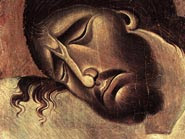Ancient-Future Festival
 KATHLEEN NORRIS IS A POET who has written bestsellers (like The Cloister Walk) on the correlation between the poetic way of seeing and the religious (or devotional) way of seeing. She’s quite popular among Evangelicals who seem to understand that they have blind spots in both areas. Some may already have intuited that their lack in one area may be connected to their lack in the other. I saw her speak some time ago. Her lecture was very un-Evangelical: no charts, diagrams, or proof-texts. It was mostly a recitation of poetry. The setting was itself poetry, a metaphor. A seminary chapel, blisteringly white, with zero art, no color, and no crucifix (just a smooth, blank cross). There was stained glass, but no pictures – except for one, apparently deemed safe enough for Protestants: it was the image of a book. It was into this barren space that the poet had been invited to reintroduce something that had been long absent, even forbidden.
KATHLEEN NORRIS IS A POET who has written bestsellers (like The Cloister Walk) on the correlation between the poetic way of seeing and the religious (or devotional) way of seeing. She’s quite popular among Evangelicals who seem to understand that they have blind spots in both areas. Some may already have intuited that their lack in one area may be connected to their lack in the other. I saw her speak some time ago. Her lecture was very un-Evangelical: no charts, diagrams, or proof-texts. It was mostly a recitation of poetry. The setting was itself poetry, a metaphor. A seminary chapel, blisteringly white, with zero art, no color, and no crucifix (just a smooth, blank cross). There was stained glass, but no pictures – except for one, apparently deemed safe enough for Protestants: it was the image of a book. It was into this barren space that the poet had been invited to reintroduce something that had been long absent, even forbidden.
Of course, the poet would be the first to tell us that words can make images. But images can be prosaic, literal and dead – like that stained glass, and the image-less word-privileging culture it represents. Perhaps the Reformers didn’t realize that words become idols just as easily as images. But suddenly, on just these issues, the Reformation seems to be up for renegotiation, a re-reformation. Many Protestants seem to be considering a line-item veto on their tradition(s). In some places, poetry, metaphor and image have begun to return to empty sanctuaries from which they were stripped.
There was a passage in William Dyrness’s Visual Faith that really got my attention, where he talks about how the Jesus Movement (the first TV generation) brought their whole culture into the church – not just their music, but their visual culture – to wide and profound effect. Certainly Cornerstone – magazine or festival – has always presented a very visual faith. Cornerstone’s sponsoring community, Jesus People USA, was born of the Jesus Movement, and has continued on in its own journey to some unexpected places. While the Jesus Movement was often notoriously anti-institutional, informal to a fault, and turned its nose down on liturgies and vestments, JPUSA has lately experimented with liturgical services, incorporation of iconic imagery and participatory elements in services; the pastors have even become known from time to time to wear vestments.
In the same way that JPUSA didn’t realize it was an “intentional community” until someone else pointed it out, we didn’t realize at first realize we were on the same worship journey as many others – until we started hearing about what has been sometimes called the “Ancient-Future” movement in worship. In 2008, Cornerstone will inaugurate a new worship venue at the festival aimed at embodying many of these impulses and bringing together various creative forms of worship that had already been spontaneously occurring in different locations around the grounds. For this year, our visual arts program, “Burning Brush,” will host a program that represents a deliberate marriage of worship and the visual arts, called “Ancient-Future Worship-Arts”. The keynote seminar will be given by Michael Van Horn, Associate Professor of Theology and Worship at North Park Theological Seminary. By coincidence (or perhaps not) that’s the same seminary where I once watched a poet bringing image and metaphor into a sterile, whitewashed chapel.







No comments:
Post a Comment